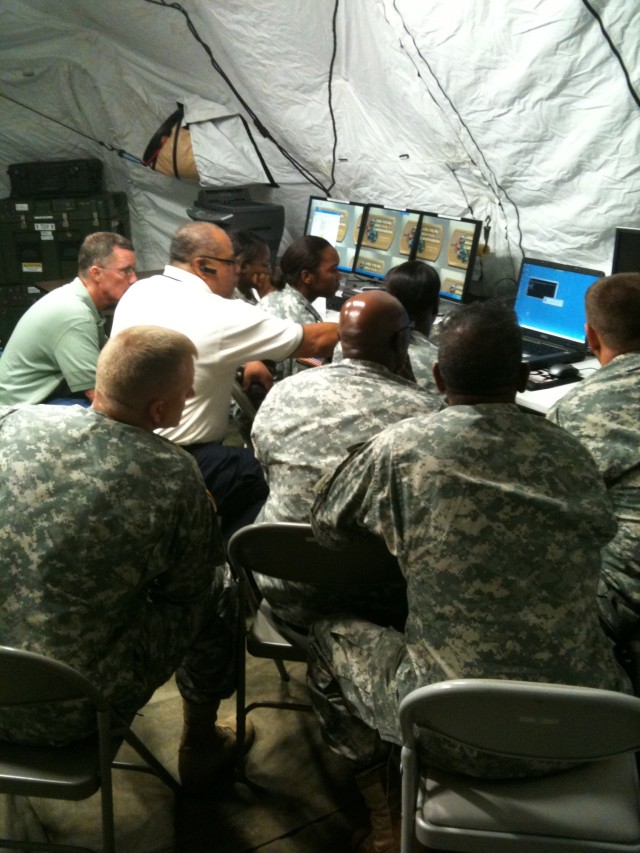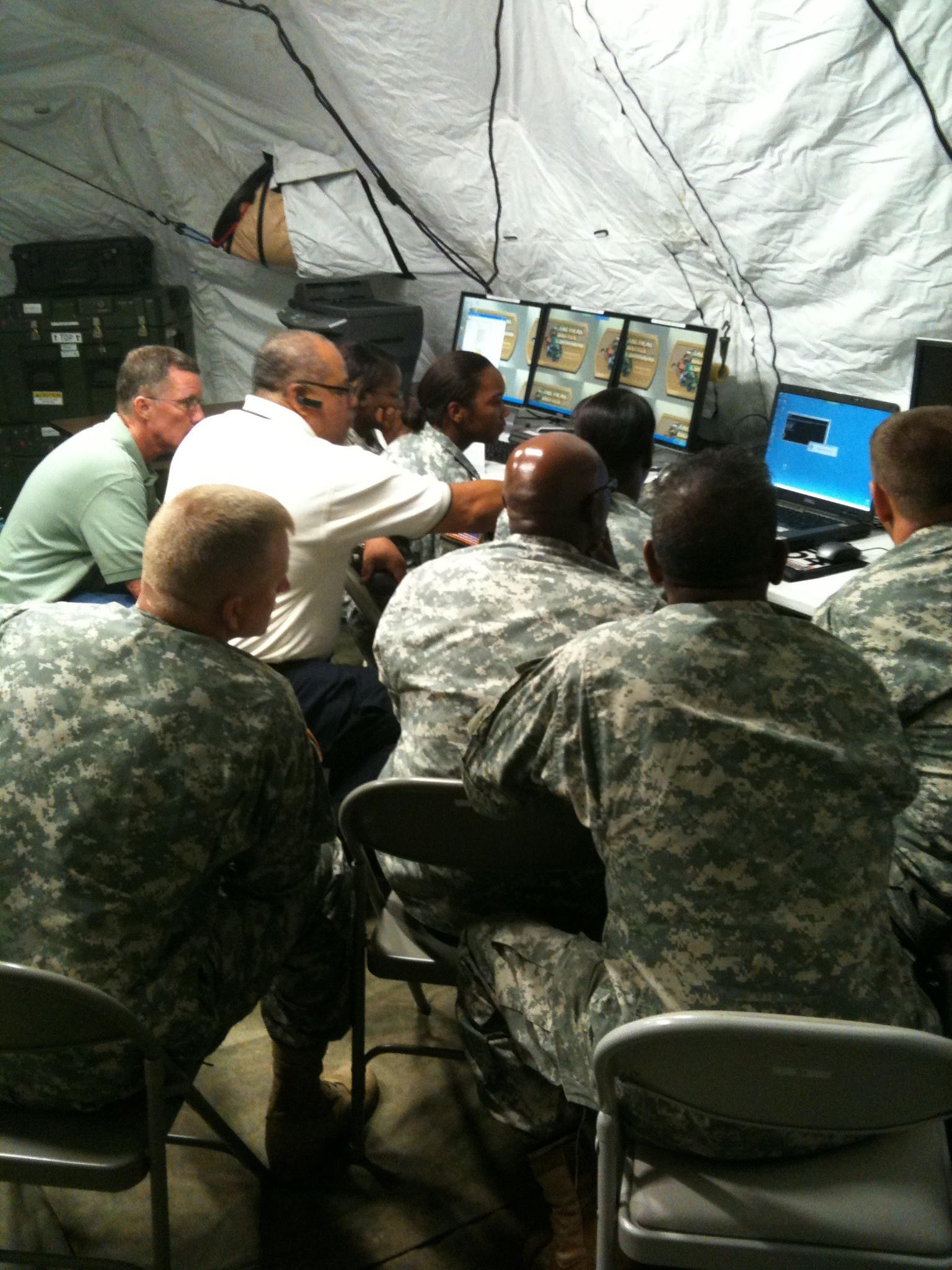FORT MCPHERSON, Ga. (August 9, 2010) - On today's battlefield, brigade and battalion Signal officers, commonly known as a battle staff's "S6," are faced with many challenges due to almost nine years of protracted conflict.
Among these challenges are the post-deployment reset of Information Technology (IT) equipment, the introduction of new technology or system upgrades, and the demands of significant turnover of trained personnel not just in the S6 sections but across an entire unit.
In recognition of these ongoing Signal-specific challenges, battalion and brigade commanders rely on their local experts, their S6 Soldiers, to provide the crucial signal training across their formations.
But, who trains the trainers'
That's where U.S. Army Forces Command (FORSCOM) enters the equation. Training a unit's Signal Soldiers to be the trainers, while simultaneously ensuring the unit's S6 section has the requisite skills, abilities and knowledge to guarantee mission success across the formation, is what FORSCOM's specialized, mobile training teams are all about. These teams, called Signal Support Teams (SST), first fielded in 2009, are staffed with Signal professionals who understand the challenges faced by other Army communication professionals at all levels.
As such, each SST is staffed with Soldiers who have had deployment experience within an S6 section. These Soldiers, who also have diverse command and control skill-sets, are teamed with contracted industry professionals. Each SST has one field grade officer, one senior NCO and five to seven contractors, based on the size and complexity of the supported unit's mission.
"The pace of continuous combat operations in two wars for more than eight years is consuming our readiness as fast as we can build it," said Brig. Gen. Ron Bouchard, the FORSCOM G6. "The SSTs are essential to assisting units to return to a level of readiness necessary to conduct future missions."
To that end, the FORSCOM SSTs provide crucial, synchronized training and assistance to Signal officers, commanders and associated staff at all levels by supplying a training resource with the necessary expertise, coupled with shared "battlefield" experiences. The intent is to provide FORSCOM's brigades and battalions with mission-oriented Signal training relevant to the challenges of today's battlefield as they prepare for future operations. This is part of the Army Force Generation (ARFORGEN) process, which is also central to FORSCOM's role as the Army's Readiness Core Enterprise.
"The FORSCOM G6 strategy is to help focus Warfighter LandWarNet requirements to enable expeditionary units at all echelons and through all phases of the ARFORGEN cycle to reliably exchange information required to perform in today's joint warfight. The SSTs are a vital component to the execution of this strategy," Bouchard said.
LandWarNet is the Army's contribution to the Global Information Grid (GIG) that consists of all globally interconnected, end-to-end Army information capabilities, including the associated processes and people needed to collect, process, store, disseminate and manage information on demand to support warfighters, policy makers, and support personnel. It includes all Army (owned and leased) and leveraged Department of Defense (DOD)/Joint communications and computing systems and services, software (including applications), data security services, and other associated services.
In the Information Age, LandWarNet alone would be enough for Signal officers to remain current on in order to provide expert advice to their commanders. But, Signal officers must also understand how information systems function and how many of them are ready to be used by their unit, while at the same time be aware of evolving hardware and software enhancements. Combine all that with the Army's expanded use of commercial off-the-shelf (COTS) equipment, and the increasingly complex battle command systems that are being fielded, and it becomes clear Signal officers and the Soldiers they lead face a daunting task. For the commanders of these Signal Soldiers, this presents a complex training challenge. Additionally, commanders face expanded tactical Information Assurance (IA) requirements that are further complicated by frequent staff assignment adjustments and substitutions.
As the primary source of Signal support to brigade and battalion commanders across continental United States (CONUS), FORSCOM G6 experts knew they needed to help by becoming mentors to unit Signal officers, S6 staffs and to their embedded LandWarNet forces. This, coupled with a growing need for specialized technical training, became the catalyst for FORSCOM to create and resource the SSTs. Essentially, traditional training programs were simply not keeping pace with technical advancements and system improvements.
To be successful, FORSCOM planners knew a specialized training program needed to be flexible enough to meet a wide variety of unit signal training specific needs and still fit into the ARFORGEN model. With that in mind, the planners knew it was also critical for Soldiers to be trained by trainers who understood the challenges they faced as communication professionals on the modern battlefield.
"With the deployment of FORSCOM SSTs, performance oriented G6 exercises typically implemented during a unit's Command Post Exercise (CPX) 30 to 60 days prior to deployment, become an effective training event for automators and communicators," said Lt. Col. Mark Haythorn, Chief, Training and Exercises Branch, FORSCOM G6.
What makes this program special is that it features experienced Signal Soldiers and civilian contractors combining their shared experience and technical knowledge to provide S6 Soldiers with highly complex technical training in an over-the-shoulder environment, so that the information is easier to understand and absorb. Ultimately, this affects Soldier readiness, enabling them to use their unique equipment in a "safe" environment to ensure they are ready to deploy.
Four SSTs have been established since the program's inception. These SSTs are able to conduct simultaneous missions for FORSCOM and be able to expedite assistance to multifunctional units. Each unit's training is tailored according to its specific needs, providing key areas of focus in server and workstation administration, tactical radio, IA, and network operations, such as connectivity to other Army Battle Command System (ABCS) enabled units.
FORSCOM units may receive SST support by submitting a request through their S3/G3 chains of command to be included in the quarterly FORSCOM G3-hosted ARFORGEN Training Support and Resource Conference (TSRC). At this conference, SSTs are resourced to units with an assigned deployment Latest Arrival Date (LAD), which includes support for active duty and compo 2/3 units. Compo 2/3 unit requests are initially presented at a unit's Joint Assessment (JA), and then presented by First Army representatives at a quarterly TSRC for SST inclusion in a unit's training plan.
Since the inception of the SST program in 2009, more than 2,000 Soldiers from 50 active and Reserve component units have been trained by the SSTs. Best practices from these units are captured and incrementally introduced into the program to sustain team proficiency, performance and relevance.
Feedback from G6/S6 personnel has been overwhelmingly positive. Requests for SST support have also been increasing monthly as word of the program spreads in the Army's G6/S6 community.
After conducting numerous SST missions for deploying units, quarterly SST training reviews identified Signal training gaps that continued to challenge FORSCOM units. The skill sets of IA, MS SharePoint and Secret Internet Protocol Router (SIPR) and Non-classified Internet Protocol Router (NIPR) Access Points (SNAP) were added to the services available to units that receive SST support to address the training gaps identified by conducting SST missions in support of the operating force. The ability of the SSTs to react to the continual modernization of technology and the needs of units is one of the major strengths of the program.
"My vision for the FORSCOM G6 is to be the preeminent provider of expeditionary campaign-capable LandWarNet Forces to Combatant Commanders," said Bouchard. "The SST is an essential piece of the equation necessary to realize this vision."
FORSCOM's support to the operating force LandWarNet Soldiers and S6 staff sections is an enduring requirement, and it will be enhanced further by the stand up of the Battle Command Assistance Teams (BCAT), starting in fiscal year 2011. Although the original mission of the SST is almost identical to the mission of the BCAT, the BCATs institutionalize the civilian members of the teams by adding Table of Distribution and Allowances (TDA) positions to replace the contracted SST personnel. The addition of BCATs will allow FORSCOM to provide support to units not only in the "Train Ready" phase of ARFORGEN, but also in the "Reset" phase.
FORSCOM, as the Army's largest command, trains, mobilizes, deploys, sustains, transforms and reconstitutes conventional forces, providing relevant and ready land power to Combatant Commanders worldwide in defense of the nation both at home and abroad. The use of its SST is yet another way the Fort McPherson-based command meets that challenge.
For more information about FORSCOM's SST program, contact LTC Mark Haythorn, Chief, FORSCOM G6 Training & Exercises Branch, (404) 464-5816 mark.haythorn@us.army.mil or forscombcat@conus.army.mil


Social Sharing